#that deals a surprising amount with politics and the psychological affects of war
Explore tagged Tumblr posts
Text
I have been watching MASH with a friend recently and, in a move unsurprisng to anyone familiar with my interests, have become fascinated with it
#talks#oh wow merle likes the show about the millitary where most of the main characters would rather be draft dodging#that starts out as a comedy but gradually gets much darker and introspective#that deals a surprising amount with politics and the psychological affects of war#who'd've thunk it#also HOLY SHIT I did not see the twist at the end of season 3 coming#its such a cultural touchpoint that I had just somehow been blind to#like the moment where it should've cut to credits but instead it cut to a normal OR scene and radar enters#and normally there'd be a comedy beat because he looks stressed but there's no joke#just the sudden realisation that something has gone#for both the characters and the audience#and it manages to carry that dark tone over to season 4 too! it doesn't back out! everything is going to get so much worse!#anyway I'm on early season 4 now so :D I'm so fascinated with where this is going to go#for a sitcom from the 70s its aged (mostly) surprisingly well
1 note
·
View note
Text
HeadCannon: Ben Tennyson and Steven Universe can’t stand one another.
Ben and Steven, while they have many things in common, would NOT get along, despite both being pretty friendly people.
This is going to be a long one folks
Methods of Addressing Problems: Combat vs Pacifisim

Ben:
Do no harm but take no s***
Fight and subdue the person causing the problem
Attempt to work out a peaceful solution
If that doesn’t work, rinse repeat until someone of authority can help or opponent gives in
He ensures that his opponent can’t cause any more harm/trouble to those around them BEFORE trying to discuss a solutions

Steven:
Sing and dance it out
Attempt peace discussions
Sing song about friendship/ the problem/potential solution or the combination thereof
If that doesn’t work,repeat
If person causing problem engages in combat, use defensive tactics and continue to attempt peace, (song is optional at this point)
Poof only if necessary
Give person time after and continue peace talks
Generally his fights are in less populated locations. Not nearly as many people are indangered when he has to fight so his surroundings are expendable.
How they Grew up and how it affects their intergalactic view

Ben has had to fight multiple sides in conflicts he didn’t fully understand. He’s had to learn that there
Multiple sides to any problem that require multiple views on how to fix things
No such thing as a simple, long term solution
Learning to delegate problems to the appropriate people and leaders
Peace Treaties are more complicated than you’d think
Society as a whole is more important, though individuals have a strong impact as to what happens to it
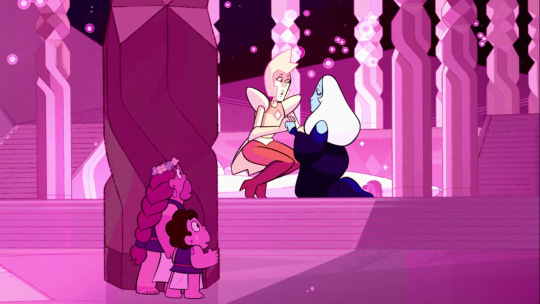
Steven fought the tail end in a two-sided war between a resistance group and an empire
Usually 2 sides to a problem
No war = no more political responsibility for Steven
See Steven Universe Movie and Steven Universe Future
Delegating problems to individuals to solve for themselves
Little Homeworld
Individuals are more important than society’s designated roles for them
Whose in charge in space
Ben:
There are still laws in space, and while you may not agree with them they are there for a reason
Hence Loopholes
Plumbers will attempt to do the correct thing (this is not necessarily the case, but it’s Ben’s perspective)
Steven:
Free frontier unless you’re on planet, and even then the laws will not be in your favor so you can get away with ignoring most of them
No one really enforces law off planet
It’s up to your to fix problems
Gems Cause Ben problems
This is where I dive more into head canons, but the Impact of Gems going across other planets with the Idea that they can do what ever they want is likely bigger than Steven first imagined.
Economics: With Gems going to other inhabited planet, they single handedly wreck their economies
Causes shrinking working class
They don’t buy anything, so the flow of money becomes stagnant
Only the people who don’t need to eat, drink, or seek medical help (ie the Gems) can continue to work in increasingly harsher conditions
Once they reach complete economic collapse, the Gems simply move on to the next planet
Steven refuses to address this problem, Making it Ben’s problem
Law: Gems don’t Respect planetary government authority nor plumber authority
Steven also refuses to do anything about this
Little Homeworld teaches Gems they can do anything they want after all
War: Conflicts over new territories would break out in mass.
With the mass withdrawal of colonies, thousands of fully formed, extremely technological planets are left unoccupied and unused.Hundreds of wars break out to claim these new territories
The Gempire doesn’t keep track of unoccupied colonial planets so they don’t know nor care
Every planet wants Ben to fight for them
Spends a lot of time negotiating peace treaties
Political Power
Both think the other has WAY too much political sway just because of who they are related to and the fact that they have cool alien powers that they totally abuse
Conflicting Personalities:
The boys are polar opposites in ways that would grate on the others nerves
Ben is arrogant and cocky whereas Steven is humble and modest
To Steven, Ben seems like a jerk

To Ben, Steven seems like a wimp

Defensive Mechanisms/ Dealing with Frustration:
Ben uses his arrogance and laid back manner as a mask to cover up how much heroing takes a toll on his mental, emotional, and psychological health
Resulting in Ben refusing to open up about how he feels on a deeper level, even with people he trusts
Steven’s powers and LITERAL being depend on his ability to be honest about how he feels, both to others and himself
Resulting in Steven trying to push others to discuss their problems mutually in order to find a solution
Both are REALLY bad at acknowledging when their family is hurting them, and get defensive about it
I’m not going into how Gwen and Kevin were outright s***** partners in crime fighting to Ben at times
See Steven Universe Future episode with White Diamond
Contrasting Views on Romantic Relationships
Ben’s Romantic Luck is terrible, and he knows relationships take the time he doesn’t have to give
Additionally, in the words of Rook, his intergalactic fame as a Hero precludes all of his Relationship attempts
Not only is he wary of new relationships, his is weary of them as well
Steven knows that relationships are formed on communication, love, and trust
See his Relationship with Connie
Envy

Ben, whether he’d admit it or not, would be envious that Steven doesn’t have nearly the amount of problems as he does [from Ben’s perspective, not necessarily true to fact]
No constant calls for help for things the Aliens can handle by themselves
No random attacks from people who want to prove themselves
No irritating fans prying into his life
Steven’s actually able to maintain relationships, both platonic and romantic
No public hatred
No plans to slaughter you from numerous terrorist groups

Steven would be envious that Ben doesn’t freak out over what should be traumatizing incidents, and that if Ben really anted too, could completely get rid of his powers [from Steven's perspective, not necessarily true to fact]
No break downs
No outbursts
No one misidentifying him
No cleaning up past mistakes made before you were even born
The longer they know each other, the more irritating the other would become in their eyes. Once Ben goes Ben 10k, I wouldn’t be surprised if there wasn’t a full out brawl or two.
Now, would they be able to play nice in the sandbox and play it professional? Of course.
Just... don’t leave them alone in a room unsupervised for too long.
[Though I will admit, due to Reboot!Ben having less experience (meaning less BS to put up with) and being easier going over all, I think he would be fine with Steven, until his dimension’s Alien’s got caught up in the Gempire mess and started coming to Reboot!Ben to fix it. Than he’d be annoyed.]
#Ben 10#Ben 10 OS#Ben 10 UAF#Ben 10 Omniverse#Ben 10 Reboot#Ben Tennyson#Steven Universe#and Steven!#Character Analysis#Relationship Analysis#Headcannons#AngryComet Rambles#This applies to my AU's#Leave your opinions below
106 notes
·
View notes
Text
Psychological analysis of Eragon. (It is not grammatically good. I know)
So I saw a post saying that Eragon was/is a sociopath. The reasoning is due to the fact that he was able to kill literally thousands of people without any thought of it or guilt afterwards. I disagree, first he is bothered by it, especially when he has the choice to not kill them and just let whoever is at his mercy go. However he should be bothered by it more, it should be more traumatizing. The reason that he isn’t traumatized in the books on a large scale is due to environment and circumstance.
He is young and therefore it is easier for him to grow to except this change from peaceful farm boy to warrior and leader. The transition between those two areas of his life was very abrupt and he didn’t have much time to digest it and come to terms with it. Especially since he was on the run learning magic and how to fight while grieving the loss of his uncle as well as trying to avenge his uncle. This was all happening at the age of 15 within a few months. Then he went from that point to losing another father figure and became someone that would decide the fate of the entire continent at 15-16.
He is moved out of his little village and is thrust into war camps and cities with people he never thought he would meets and he now has massive amounts of political power and influence that he never had before as a poor farm boy in a tiny village. He’s 16. It’s a lot of stuff to adjust to and process, as soon as he starts to get used to it and figure things out he has to leave the society he has adjusted to a little bit and go to learn a decades worth of knowledge in a short time because they don’t have very long. He has also sustained a crippling injury which puts even more pressure on him than there already was. He has excepted that he is supposed to be the one to kill the tryrannical king but doesn’t have a clue in how to accomplish such a thing.
During this whole thing he is experience what it to be in love with someone for the first time in his life and that love is unrequited. He’s an awkward hormonal teenager who hasn’t had much interaction with girls his age that he saw as an option. Katrina was someone he believed would one day be his in-law and viewed her as such. Now he is friends with this beautiful, powerful, older female. She rejects him, that’s one more thing he has to process. Her rejection is right on the heals of a bodily transformation which will take a huge effort to adjust to in a short amount of time. He is faster, stronger, his senses are enhanced and he has some hope that he could possibly kill the king. Then he almost immediately has to go to fight in a battle against a massive army, surprise surprise he has a brother and believes his father is an absolute monster and is reunited with his cousin only to almost immediately go to kill the people that killed his father figures and other people he grew up who also burned down his entire home village, and they have kidnapped his beloved cousin’s future wife. Those creatures are also protected by a huge city. He has had no time process the battle he has just gone through. After all of that happens and they rescue her and a bunch of other stuff happens that ads to the stress of the task he has to accomplish.
He is seen almost as a god to some people and the whole outcome of the war lies primarily on his shoulders, he’s probably about 17 at this point. He’s the age of a junior in high school. His brain still has like 8 years to finish its first phase of developement. During all of this, somewhere near the end of book 3, someone tries to kill him and almost succeeds. Then he finds out he’s not the son of a monster but one of his father figures that he watched die. Then goes to fight in another battle and watches another father type figure and teacher die. Right before this he finds out about something that could change the course of the war in his favor possibly.
Then another battle comes and goes, he almost loses his cousin. He gains the motivation and a need to become a more skilled fighter in a condescending amount of time and become more masterful in magic. Then more stuff happens that includes some battles and near death experiences. One of his closest friends who is also one of the leaders of their rebel forces who is also the one who planned and strategized most of their battles. She’s gone and their enemy has her, he is her successor and has to go on a journey to get something he needs to become powerful enough to defeat the king. He gets it, goes back to the war camp and fights the big bad. He wins and now has to decide if he’s going to be king or not, he makes the smart decision and doesn’t do that.
Now he has to take on the responsibility to rebuild the dragon riders and raise dragon and help maintain peace which is going to take decades, even centuries. He literally doesn’t have the time to process anything and if he does he will most likely have a complete breakdown from all of the trauma he lives through within a span of a few years as an adolescent. At some point when he no longer has so many responsibilities all of it is going to come back to him and he’s going to experience the emotional and mental affects of what he went through. Not only that but he’s going to process how many people he had to kill to take down the big bad during the war because he was their biggest weapon and was constantly on the fronts lines. Every battle that he went through heavily relied on him cutting down and scaring the opposing forces.
In conclusion, Eragon has yet to process what happened during his adolescence and probably won’t for the next few decades or maybe even centuries. When it does he’s going to go into a downward spiral. He’ll probably have to take some time away from everyone and everything so he can deal with it and heal.
121 notes
·
View notes
Text
Transmediale 2019
The transmediale 2019 was a festival with out a topic. The organizers wanted to leave it open this year avoiding to give a specific direction or tone for emerging thoughts and content. The theme of the festival program was built around the question of: What moves you? Emotions and feelings were examined in talks, workshops and performances to open up discussion about the affective dimensions of digital culture today.
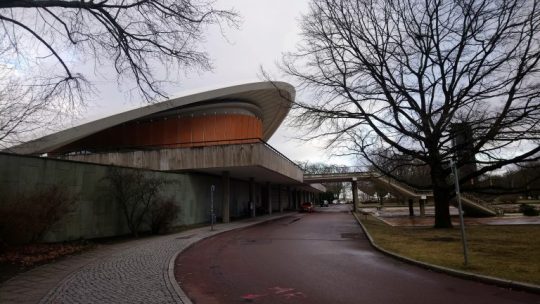
Transmediale at Haus der Kulturen der Welt
Of course it is impossible to attend all of the program, so I console my self with the knowledge that part of the program I missed i can usually catch later on transmediales YouTube channel where they publish most of the talks and panels.
Following some of my transmediale 2019 highlights:
Workshop(s)
I had the chance to get to Berlin a bit earlier to attend Adam Harvey’s (VFRAME) and Jeff Deutch (Syrian Archive) workshop Visual Evidence: Methods and Tools for Human Rights investigation. The workshop centered around the research and development of tools to manage a huge amount of video material from conflict areas, specifically Syria. The Syrian Archive collects material intending to documented and archive evidence for possible future use in trying to hold war criminals accountable for their actions. The challenge for human rights activists working with footage from Syria is that there is a massive amount of material. Manually sorting out the relevant videos for archiving is just requiring too much time. To tackle this challenge the Syrian Archive started a collaboration with artist Adam Harvey to develop computer vision tools aiding the process of finding relevant material among hours of footage. Videos often filmed by non professionals in violent, often life threatening, situations (a very specific video aesthetic which is relevant when training object recognition).
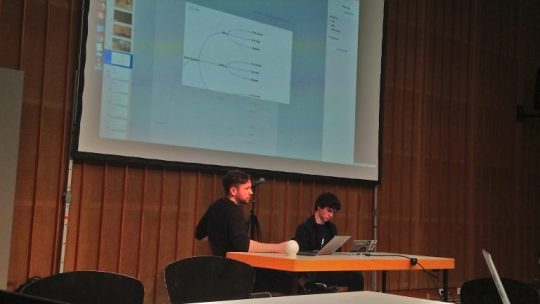
Adam Harvey describing the process of developing object recognition tool.
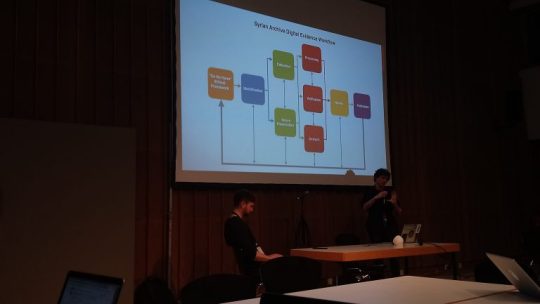
Jeff Deutch describing the workflow of verifying evidence.
After learning about the archiving challenges of human right activists Adam took us trough the process of developing VFRAME (Visual Forensics and Metadata Extraction) which is a collection of open source computer vision tools aiming to aid human rights investigations dealing with unmanageable amounts of video footage. The first tool developed was simply per-processing frames for visual query. A video was rendered to one image showing a scene selection. This helped the activist to see the different scenes of a video in one gaze enabling them to process the information of a several minute long video in just 10 seconds. Now the workflow was much faster, yet it would still take years to process all of the video footage. What the activist were looking for in the videos was evidence of human right abuses, children rights abuses, and also identifying illegal weapons and ammunition. To automatize some of the work load, as a first step, Adam and the Syrian Archive has started an object recognition training of a neural network to identify weapons and ammunition. Adam used the example of A0-2.5RT cluster munition as an example to talk about the challenges they had.
Adam showed us a tool that they have been using for annotating objects, but it has been time consuming and a greater challenge was not having enough images to actually train the network. While working with the filmed footage the activist had learned to see patterns how the object (in this case A0-2.5RT) was appearing ( eg. environments, light conditions, filming angel etc.). Hence one successful solution was to synthesize data, in other words to produced 3D renderings of the ammunition simulating the aesthetics of the documented videos. The 3D renderings with various light conditions, camera lenses, filming angels provides the neural network with additional data for training. Adam also showed experiments with 3D prints of the A0-2.5RT, but according to him it is way more effective to use the photorealistic 3D renderings.

3D print: part of a A0-2.5RT cluster ammunition.
In a panel discussion later during the conference (#26 Building Archives of Evidence and Collective Resistance ) Adam was asked how he felt about developing tools that could possible be missed used. From Adams perspective he was actually appropriating tools that are already misused. VFRAME provides a different perspective for use of machine vision in a very specific context. During the Q&A the issue of bias data sets was questioned. With the context of this case study Adam made it clear that bias actually needs to be included in the search of something very specific. For him the training images needs to capture the variations of a very specific moment, for him bias included e.g. the camera type that is often used (phone), height of the person filming (angel) the environment where the ammunition is often found (sometimes on the ground, or someone holding it in their hands etc.). When trying to detect a very specific object in a very specific type of (video) material, then bias is actually a good thing. Both during the panel and in the workshop it was made clear that the processing large amounts of relevant video material and talking with the people capturing the material on site was very valuable when creating the synthesize 3D footage to train object recognition.
After Adams presentation of the VFRAME tools the workshop continued with Jeff Deutch taking us through processes of verifying the footage. Whereas machine learning is developed to flag relevant material for the activists, a important part of the labor is still manually done by humans. One of the important tasks is to connect the material together validating the date so it can be used as evidence. Jeff us a couple of examples how counter narratives to state news was confirmed by using various OSINT(Open source intelligence) tools such as revers image search (google, tincan), finding Geo-location (twitter, comparing objects and satellite images from Digital Globe), verifying time (unix time stamp), extracting metadata (e.g. Amnesty’s Youtube DataViewer), and collaboration with aircraft spot organizations.
The workshop and the panel were extremely informative in terms of understanding workflows and how machine vision can be used in contexts outside surveillance capitalism. The workshop had also a hands on part in which we were to test some of the VFRAME tools. Unfortunately the afternoon workshop was way to short for this and some debugging and set up issues delayed us enough to be kicked out from the workshop space before we could get hands on trying the tools.
After the transmediale I had the chance to visit the Ars Electronica Export exhibition at DRIVE – Volkswagen Group Forum. There the VFRAME was exhibited among other artworks. It is definitely one of these projects which mixes artistic practice with research and activism emphasizing the relationship between arts and politics. Another transmediale event that related to the workshop and panel mentioned earlier was a very emotional # 31 book launch of Donatella Della Ratta’s Shooting a Revolution. Visual Media and Warfare in Syria. In the discussion there was several links between her ethnographic study and the work of the Syrian Archive.

VFRAME exhibited at the Ars Electronica Export exhibition
Talks
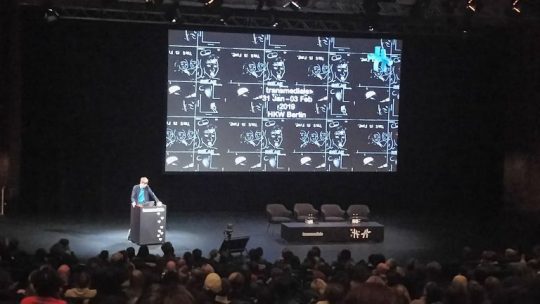
Opening talk by Kristoffer Gansing, Artistic Director of transmediale.
In the #01 Structures of Feeling- transmediale Opening there was some interesting references to machine vision. New York based artist Hanna Davis was presenting her current work generating emotional landscapes experimenting with generative adversarial networks and variational autoencoders. Basically the landscapes (e.g. mountains or forests) was tagged with emotions (anger, anticipation, trust, disgust, sadness, fear, joy, and surprise or ‘none’) buy Crowdflower platform workers (similar to Amazon Mechanical Turk). Then machine learning algorithms were feed with the data set to generate “angry forests” or “sad mountains” etc. The 20 minute talk was definitely a teaser to look more closely into Hannah’s work. Next up was Anna Tuschling who mentioned a number of interesting examples. With a background in psychology she talked how we have tried to understand and represent emotions coupling e.g. neurologist Duchenne de Boulogne’s work in the 1800s with facial recognition technology and applications such as Affectiva (“AFFECTIVA HUMAN PERCEPTION AI UNDERSTANDS ALL THINGS HUMAN – 7,462,713 Faces Analyzed”) and Alibaba Group’s AliPay’s ‘Smile to Pay’ campaign in China.
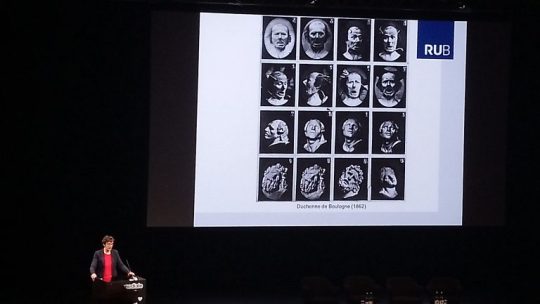
Anna Tuschling taking about neurologist Duchenne de Boulogne’s work
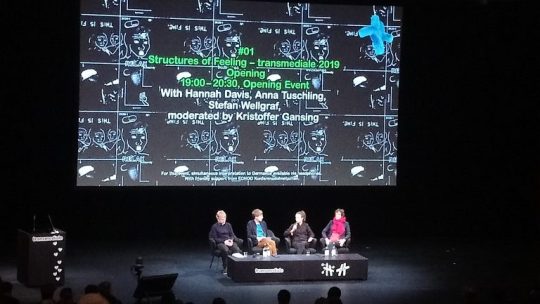
Structures of Feeling – transmediale 2019 opening panel with Hanna Davis, Anna Tuschling and Stefan Wellgraf, moderated by Kristoffer Gansing.
From the #12 Living Networks Talk, Asia Bazdyrieva’s & Solveig Susse’s Geocinema awoke my interest. They considers machine vision technology such as surveillance cameras, satellite images an cell phones together with geosensors an cinematic apparatus sensing fragments of the earth. The # 15 Reworking the Brain Panel with Hyphen-Labs and Tony D Sampson was not quite what I had expected, yet Sampson’s presentation connected with the readings we done on the non-conscious (N. Katherine Hayles, Unthought). He reflected on how brain research has started to effect experience capitalism (UX Industry) asking “What can be done to a brain?” and “What can a brain do?”. In the Q&A Sampson revealed a current interest in the non-conscious states of the brain while sleep walking which I found intriguing.

NeuroSpeculative AfroFeminism (NSAF) by Hyphen Labs
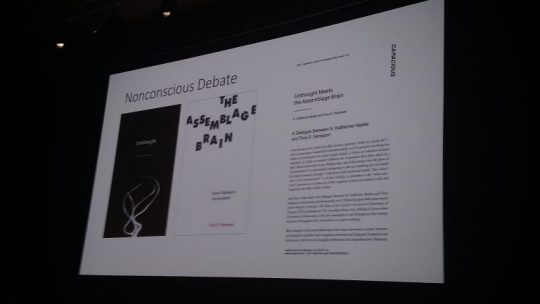
Nonconscious debate Hayles/Sampson.
In my opinion one of the best panels was #25 Algorithmic Intimacies with !Mediengruppe Bitnik and Joanna Moll, moderated by Taina Bucher. The panel discussed the deepening relationship between humans and machines and how it is mediated by algorithms, apps and platforms. The cohabitation with devices we are dependent on was discussed through examples of the artists works. !Mediengruppe Bitnik presented three of their works Random Darknet Shopper, Ashley Madison Angels and Alexiety. All of the works asked important questions about intimacy, privacy, trust and responsibility. The Ashley Madison Angels work bridged well with Joanna Molls work the Dating Brokers illustrating how our most intimate data (including profile pictures and other images) are shared among dating platforms or sold forward capitalizing on our loneliness. Ashley Madison is a big dating platform that is specially marketed to people who feel lonely in their current relationship (marriage), so it encourages adultery. In 2015 the Impact Team hacked their site, while the company did not care too much about the privacy of their customers, the hackers dumped the breach making it available for everyone. The dump was large containing a huge amount of profiles, and also source code and algorithms. It became an unique chance for journalist and researchers to understand how such services are constructed. Among others !Mediengruppe Bitnik was curios to understand how our love life is orchestrated by algorithms. What was discovered from the breach was an imbalance between male and female profiles. The service lacked female profiles and due to this they had installed 17.000 chat bots. !Mediengruppe Bitnik thought that there would be amazing AI developments in creating these bots. They were to have conversations with clients from different cultures, in various languages about a number of topics. But it turned out to be very basic chat bots, with 4-5 A4 pages of erotic toned hook up lines. A well choreographed flirting was enough to keep up the conversation and the client paying for chat time. In the Ashley Madison Angels video installation the pick up lines are read by avatars wearing black “Eyes Wide Shut” type of venetian masks. After the talk I asked Carmen ( !Mediengruppe Bitnik ) about the masks. She told me that they were a feature provided by the service, as a playful joke to add on your profile image. Actually all the bots profile images were masked with the feature so that the profile images could not be run through e.g. googles revers image search to confirm abuse of profile images. In the end the chat bots were using 17000 stolen, maybe slightly altered id’s of existing people. Carmen also noted that the masks would not work anymore whereas google can now recognize a images as a duplicate using just parts of the image/face. In connection to the Ashley Madison bots also the army of human CHAPTA solvers was mentioned in the talk. There is a effective business model exploiting cheap labor to solve CHAPTAS for bots almost in real time.
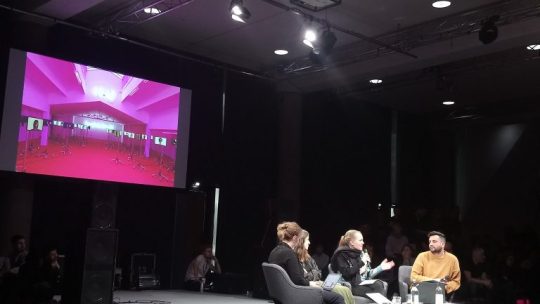
!Mediegruppe Bitnik talking about their work Ashley Madison Angels.
Joanna Moll continued talking about the “dating business”. Together with the Tactical Tech Collective she has researched in how dating profile data is shared and sold by data brokers. For her work Dating Brokers she bought one million profiles for 136€. These profiles (partly anonymised) can be browsed through using the interface she created. Additionally a extensive report on the research part of the project can be read in The Dating Brokers: An autopsy of online love. The report describes common practices of so called White Label Dating. While no one wants to be the first person registering onto a dating platform there is a common practice to either share data among groups of companies. When agreeing to the user terms ones profile can be shared among “partners” that can reach up to 700 companies having legal access to the data. Additionally the profiles are sold in bundles like the one million profiles Joanna bought from the dating service Plenty of Fish. The data set included about 5 million images, and I would not wonder if these images end up fed into neural networks hungry for faces to recognize.
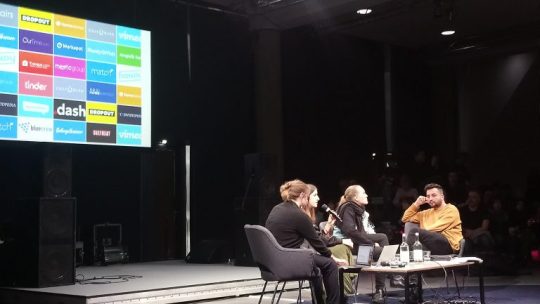
Joanna Moll reporting on her research for The Dating Brokers: An autopsy of online love.
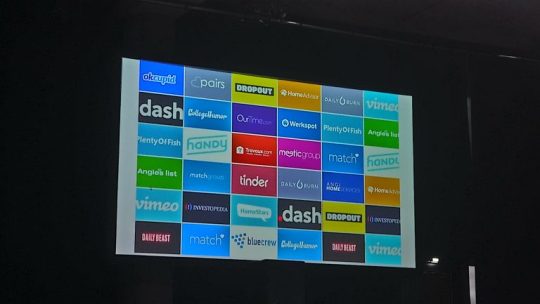
Dating profiles can be shared among partners, this means your data can legally be breached up to 700 companies.
There was several interesting talks about the commons, machine learning, affect and other topics, yet the talks described here more or less relate to my research.
Written by Linda Kronman - Full text here
0 notes
Text
Lost Light #5 Thoughts & Feels
Okay, because of IRL circumstances, I had to skip on a thought&feels post for #4. Unfortunately, I doubt it's something I'll ever get back to. So please accept my sincerest apologies as we leap straight into Lost Light #5: Modes of Production.
As always, under a read more for massive spoilers.
+recap of issue #4: EVEN MORE FUNCTIONISTS!
+I'm loving the Council cover. They look suitably menacing.
+I'm honestly touched by this moment between Rung and Nightbeat. Nightbeat, guessing that Rung would rather suffer in silence, decides to track him down so he can help him. It's so sweet how Nightbeat offers to be an outlet for Rung's pain.
+Rung has friends who care about his emotional well-being!
+Buuuuuuut, well. Not to throw poop all over his thoughtful gesture but Nightbeat is not exactly known for his tact or understanding >_>... Add to that the fact that he's currently taking an emotion blocking drug... Let's see how this goes!
+Not gonna lie. I've always lowkeyed shipped Nightbeat/Rung. This issue is not helping XD
+Look at Rung's face! He misses Skids so much Q_Q
+”It's not Skids. I mean, it is Skids, but-”
SCREAMING
“-It's everything else, too. It's me.”
MORE SCREAMING
+Don't you be hurting Drift's BFF!
+I like the call back to Rodimus being a past Matrix holder. Noice.
+It's hilarious how much the Council buy into their own BS : | and when I say hilarious, I actually mean pathetic and a little bit terrifying.
+Gawd, I'm loving all this Rung stuff. I'm so sorry, everyone. I think much of this issue is going to be me cooing over Rung.
+I did wonder how Rung was coping with retirement. I think maybe one to two months have passed since the get of #48/49 and there was never any follow up to Rung's resignation. Like, how did his patients feel? How did that affect Rung' relationship with the rest of the crew. Did he take on a new position?
Rung talking about his self-worth, and how his job helped him deal with that, is actually kinda heartbreaking when you take Cybertronian society into account. Being without a job is not the same for other bots as it is for Rung. I hate to say it but, in a gross-oversimplification of the Cybertronian culture, a functional alt-mode is a safety net, psychologically if not job wise.
A jet can be a scientist or a cook, anything they want, but they will always have the comfort of knowing, if all that falls through, they're still a jet. There is not such comfort for Rung.
+”If it's a choice between us killing him and you using him... No contest” Ratchet continues to be awesome in everything he does *fans self*
+I wanted to bring this up after reading #4 but didn't get the chance. For the longest time I've wondered why the Council had such power and political influence. After all, religious doctrine can only get you so far. Well, I must say, turning into the key to Vector Sigma... Yeah, that'll do it.
Except that seems to be complete BS. So feck those guys.

Damn! FU!Rung is on fire!
+Luna 2 looks so cool. If it doesn't end up being a Proto-Unicron then I'll be super miffed.
+I spy a teeny Minimus amongst the destruction.

+I do like when Megatron is all comandery.

Tiny glasses
+Poor Roller misses his pal :( I wonder if he knows Orion Pax became Optimus Prime. Has anyone told him yet? Ratchet, come on. He has a right to know!
+Speaking of Roller, I wonder if his drugs problem will ever be addressed.

Proceeds to describe in great detail what he thinks happened to Orion Pax. Yeah, sure you haven't XD
+YAY! TEN AND SWERVE ARE OKAY!
+Supportive Cyclonus is best Cyclonus.
+This is easily my favourite panel in the whole comic.

+So, it looks like we won't be getting a immediate conclusion to the Tailgate/Whirl cliffhanger. I'm actually glad of that. Abuse(intentional or not) is a very delicate issue and needs to be handed as such. There's too much going on in this issues to give it adequate panel time.
+I've actually seen some folks complain about the lack of follow up, accusing Roberts of dropping an important plot thread or even outright ignoring it. Really? James Roberts. James seeded-the-beginnings-of-Elegant-Chaos-as-early-as-Chaos-Theory-or-Issue-one-of-MTMTE Roberts? REALLY?
+May 10th is Brainstorm day! Spread the word!

YES! Ever since its introduction, I've always hoped we'd see some in-universe examples of individuals affected by it!
+Rung is admitting that he can't remember his early life or his exact date of birth. And we're not talking a few days or weeks. Oh no. Rung has narrowed his birth down to six or seven million years ago. SIX OR SEVEN!? That's at least a millions years unaccounted for. That's a ridiculous amount of time!
+btw Rung has some very nice lips in this panel.
+Are they implying Rung used to know what he did?
+Clicker is so precious!
+YAY! It's Sweep! I'm surprised we haven't seen Quark yet.
+ghpdjfngh[ojkfnh]pmfghpo
+WE KNOW WHAT RUNG DOES!
+I actually gasped. We knew Rung's function scared the Council. The second these crystals were revealed to be photonic crystals I lost it. Like, holy shit. Rung can make photonic crystals! A crucial ingredient in created constructed cold bots. It disproves everything the Council has ever preached. My poor brain honestly cannot fully comprehend all the implications @_@
But the biggest thing that sticks in my mind is this. At this point, without the pulses from Vector Sigma Rung is the only thing capable of creating new life, but that's only if Vector Sigma itself is still active, which it appears to be both in this universe and the main one. For ages, we've been lead to assume that cold construction is an "unnatural" form of creation. But Rung's existence completely turns that on its head. Did the planet create Rung because it knew its pulses were a temporary thing? Why is there only one of him? What was all that stuff Rung was implying, about making the crystals before. If he did used to make them, then why did he stop? There's so much going on! I also don't think we've gotten the full story yet.
+What does this mean for Cybertron's future? Why are the crystals in Drift's vision?
+”I'd produced them unexpectedly. A physiological response to an intolerable psychological burden.”
So... That's the trigger?

Oh...
+So Skids' death for Our!Rung was mentally equivalent to two millions years of torture. My littler shipper heart isn't sure how to process this information.
+... Does this mean we might get Skids back? How much residual spark energy is needed to fill a crystal?
+Okay, I'm down with Rung's function but if he can form crystals with his hands/spark then what's the point of his alt-mode?
+Our!Rung has produced seven crystals. I wonder if that's going to be important later.
+Pssst, it totally will be.
+The Nightbeat/Rung shipper inside me just squeed.
+I love Nightbeat here. He's got his arm around Rung's and is all “Sorry, mate. I don't have the foggiest but I'm gonna try my best to be here for you.”
+The Matrix is a photonic crystal. I wonder if Rung can fix it... or if he made the original O_O

+I'm not sure how to feel about Terminus. I don't think he's informed enough to advise Megatron in this situation. He didn't experience the war. He didn't see the atrocities committed by his friend. Megatron told him as mush as he could, but it's no replacement for first-hand experience.
However, I do understand him trying to save his friend. It's rather endearing, in it's own way.
As for the situation, Megatron remaining on Functionist!Cybertron, I would honestly be fine with Megatron staying. I'm paraphrasing a bit, but Roberts once said he couldn't have Prowl on the Lost Light because every single story would be about him. Prowl actions have effected so many people, there'd be no way to avoid it. Unfortunately, the exact thing has happened with Megatron, who's like a Prowl turned up to eleven when it comes to horrific deeds committed against the Cybertronian race. While I've enjoyed the ride, I feel other characters stories are starting to suffer.
+I honestly love Megatron in this scene. He's not trying to justify or deny his past crimes.

Yaaaasssss

:(
+This theory was guessed as early as issue two(maybe even issue one) so, sadly, learning Lug has been a hallucination this whole time loses a little of it's emotional impact. Stilled bummed, though. I really liked Lug. I can only hope that Lug survived and is out there, somewhere.
+This is comics land so no one is dead until we see a body! ANODE! GO FIND HER STATUE!
+FU!Rung is competent as hell.
+Rewind and Chromedome are quite sweet here. Comforting each other whilst Rung lays out the Council's plan for galactic conquest.
+Rewind, once again, explains why Cybertronians are massive pricks. Seriously, though, Rewind isn't wrong. What is with Cybertronians and genocide?
+My god. The Council really are a bunch of hypocritical pricks.
+”Hold that heroic thought” is a great line and I must find a way to work in into normal conversation.
+Rodimus squealing brings me joy. The circle of squee is complete.
+Poor FU!Rung. He looks so tired... but that doesn't mean he's not ready to throw down!
This is my second favourite panel.

+As much as I love any and all versions of Rung, I'm amazed Rodimus didn't laugh in his face.
+Serious talk. A lot of people have been so quick to assume Rodimus is going to kick Rung's tiny back wheel. And yeah, it seems like an obvious assumption to make. But I've been doing a bit of thinking... Our!Rung's weapon of choice is a staff. In a war lasting millions of years, fought mainly with some sort of long distance laser weaponry, our tiny Psychiatrist decided that he would use a staff. Hm, maybe we'll all be surprised.
+NEXT ISSUE NOW PLEASE!
18 notes
·
View notes
Text
Why Iran Waits
Staying in the Nuclear Deal Is Its Worst Option, Except for All the Others
Henry Rome
HENRY ROME is an Associate at Eurasia Group, a global political risk research and consulting firm / FA
Shortly after U.S. President Donald Trump withdrew from the Iran nuclear deal, Supreme Leader Ayatollah Ali Khamenei pledged [1] that Iran would not tolerate the simultaneous restriction of its economy and its nuclear program. “This bad dream will never come true,” Khamenei said in June 2018.
Yet Iran has accepted exactly that. Iran has continued to comply with the restrictions on its nuclear program under the Joint Comprehensive Plan of Action (JCPOA), which was implemented three years ago this month. And Trump reimposed unilateral sanctions in August and November 2018, which means that Tehran is also bearing severe economic costs. Iran has never before endured this combination of economic sanctions and nuclear restrictions. As policymakers and analysts debate how and whether to keep Iran in the JCPOA, it is important to understand why Iran has stayed put in the first place—and will likely continue to do so this year.
We should not begin by imagining that Iran will stay in the nuclear agreement regardless of the cost—or that its leaders are counting on [2] simply waiting out Trump. In fact, withdrawing from the agreement, or taking small measures to violate it, could help Iran build leverage against the United States for future talks, even while distracting the country’s population by reinforcing the government’s mantra of resistance. Nor does Tehran need to fear that withdrawal [3] will necessarily lead to war [4]: Iran could take small steps [5] to violate the agreement [6]that would not meaningfully affect its breakout time—the time required to produce enough nuclear material for a bomb—and then argue that the steps are easily reversible should the United States return to negotiations.
Rather, the Iranian leadership, through its complex and opaque [7] national security decision-making process, has apparently conducted a cost-benefit [8] analysis [9] and decided to stay. The decision is likely based primarily on economics, but is also driven by strategic considerations and the diplomatic benefits of staying in the deal.
MONEY TALKS
The most salient factor in Iranian calculations is economic. Since U.S. sanctions were reimposed in November, two observations have become unavoidable. First, while U.S. sanctions are potent, they are not as effective as the previous multilateral measures. Second, for Iran, the economic downside of leaving the deal would be considerable.
Iran’s oil sales and Europe’s efforts to bypass U.S. sanctions buttress these conclusions. The threat of U.S. sanctions triggered a sharp decline [10] in Iranian oil exports: from 2.4 million barrels per day (bpd) in May to approximately 1.25 million bpd in November [11]. But exports are likely to rebound to 1.5 million bpd early this year, making the overall decline smaller than political and market analysts predicted. Driven by concerns about domestic gasoline prices, Washington has shown a surprising degree of flexibility, issuing exemptions that allow eight countries to continue buying Iranian crude and condensate.
The situation for Iran is far from ideal. Iran must sell oil at a discount, pay for the shipping and insurance, and bear storage costs. Its revenues are locked up in special escrow accounts in purchasing countries. But the volume of oil sold is still substantial—and well above one million bpd, which is Tehran’s psychological and financial threshold. If Iran violated or withdrew from the JCPOA, it would jeopardize some of these sales. Among Iran’s top buyers, Japan and South Korea would be the most likely to halt purchases if Iran stopped complying with the deal. Such a loss would be unacceptable for Tehran, especially for the condensate industry, which relies on exports to South Korea.
A similar logic applies in Europe. France, Germany, and the United Kingdom are working with the European Union to establish a payment mechanism to bypass U.S. sanctions. The so-called special purpose vehicle would almost certainly not handle large-scale trade [12], such as with oil. But it could provide companies and banks a channel for legal, humanitarian trade with Iran [13]. Establishing a pipeline for humanitarian goods will become increasingly important in the coming months as medical shortages intensify [14]. European countries would most likely sever this connection if Iran stopped complying with the JCPOA.
STRATEGIC PATIENCE
Staying in the nuclear agreement benefits Iran’s regional policy. Preoccupied with saving the nuclear deal and wary of antagonizing Iran, world leaders have largely overlooked the country’s nonnuclear activities. The situation is ironic, given that the Trump administration justified withdrawing from the JCPOA in part to allow the world to better address the “totality” of Iranian activity [15]. Instead, by endangering the accord, the U.S. administration has ensured that international—and especially European—attention focuses exclusively on preserving it.
Iran continues to develop and test ballistic missiles unabated. In the past, the United States and Europe built an international consensus about the missile threat—and, indeed, the United States and European allies were negotiating the potential for new ballistic missile sanctions early last year. But those talks evaporated once the United States withdrew from the deal. Iran’s ballistic missile test in December barely elicited an international response [16], let alone sanctions or other measures. Secretary of State Mike Pompeo’s warning [17] earlier this month about Iran’s testing of space launch vehicles similarly fell on deaf ears.
Meanwhile, Tehran’s alleged efforts to eliminate dissidents and separatists in Europe have gone largely unanswered. European intelligence services blamed Iranian agents for attempting to bomb an opposition conference in France [18] and assassinate Arab separatists in Denmark [19] last year. The European Union on January 8 issued several sanctions designations [20] in retaliation, but they amounted to little more than a slap on the wrist.
Iran is also rapidly changing the delicate rules of the game [21] with Israel in Lebanon. In recent months, Israel has accused Iran of constructing small factories in Lebanon to allow Hezbollah to indigenously produce precision missiles [22]. For Iran, this strategy reduces the risk of transferring missile components from Syria to Lebanon in convoys that Israel routinely bombs. Regardless of the Trump administration’s eventual decision about troop levels [23] in Syria, Iran’s Lebanon strategy will pose an increasing risk to Israel, which has tried in vain [24]to bring this development to international attention. If Tehran withdraws from the JCPOA, international concern about its regional activities will likely grow and will limit its maneuverability. Staying in the deal is an attractive alternative.
INTERNATIONAL SUPPORT
Finally, Iran has enjoyed a diplomatic boost by continuing to implement the agreement. Over the past five years, President Hassan Rouhani and Foreign Minister Javad Zarif have labored to improve Iran’s international reputation [25]. The nuclear deal was the pinnacle of this effort. Trump’s verbal assaults on Tehran and departure from the deal have led other world powers to give Iran a diplomatic bear hug. Nowhere has this been more evident than at the United Nations Security Council. In September [26] and again in December [27], the United States stood alone in condemning the nuclear agreement, while delegates from Europe, China, Russia, and elsewhere uniformly praised its importance and Iran’s compliance.
Claiming the so-called moral high ground [28]has helped Iran expand trade and diplomatic relationships. And its compliance, routinely affirmed [29] by international inspectors, has blunted calls from the United States and Israel to dig deeper [30] into Iran’s past nuclear activities. Still, retaining the high ground is relatively less important than the economic benefits of staying in the agreement. The high ground does not pay the bills.
EXIT STRATEGY
Contrary to its leaders’ public posturing, Iran will likely spend 2019 inside the nuclear deal while muddling through a severe economic contraction [31]. But Iran’s calculations will begin to change if the deal stops yielding economic benefits or if the international community begins cracking down on its regional activity.
The next U.S. decision on oil waivers in May could mark a turning point. Washington is confident that with increased global oil supply, combined with slowing international demand, the U.S. will have the leverage to further depress Iranian exports, perhaps lower than one million bpd. If this happens, observers should not be surprised if Khamenei makes good on his pledge.
0 notes